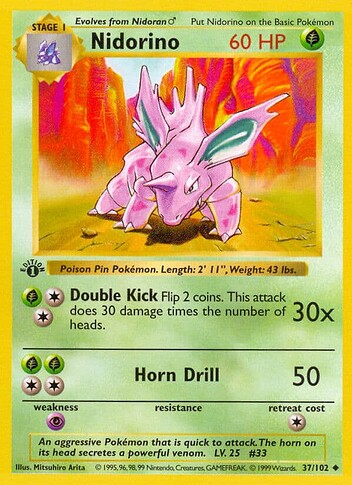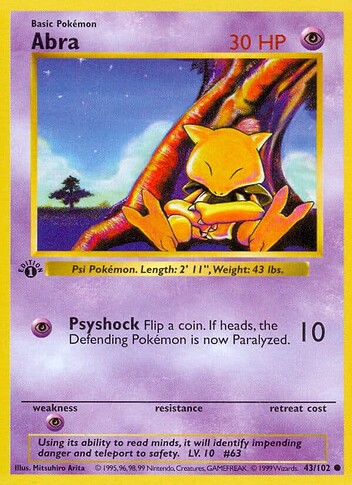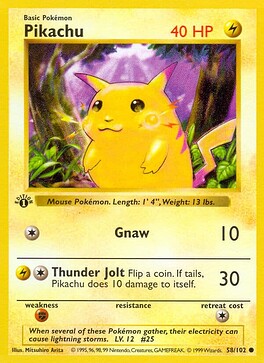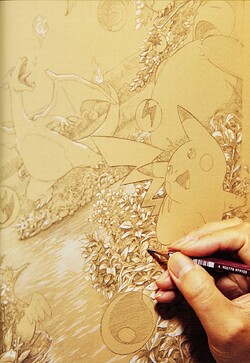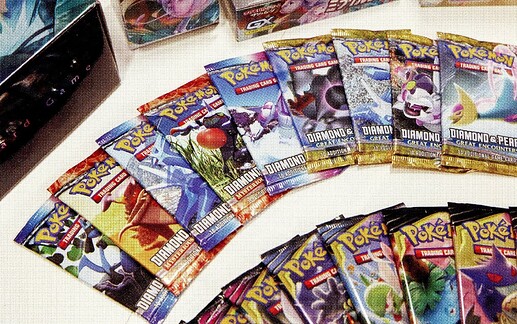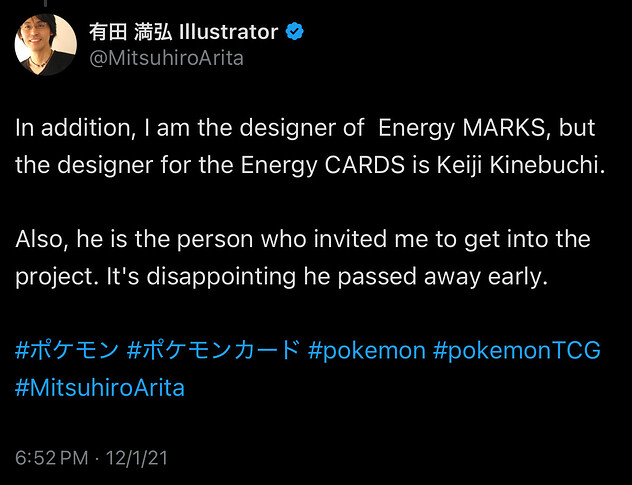Was able to translate the interview Arita gave in 2020 for the illustration Magazine. It’s full of interesting information regarding his involvement in the tcg and how he goes about making great illustrations from his perspective. If you’re an Arita fan, I highly recommend reading it, so grab a beverage of your choice and enjoy.
Thanks to @BANKS for helping out with some of the translations.
Bio:
Illustrator. Born in Fukuoka in 1971. Worked as a freelance illustrator since 1996. He has continued to provide illustrations for the "Pokemon Card Game'' from the first game to the latest, and has drawn over 550 cards to date. Other work includes content illustrations for the "Final Fantasy'' official website and concept design for the "Berserk the Movie: Golden Age Arc'' trilogy."
Q:
You have been creating illustrations for the Pokémon Card Game for over 20 years, starting with the release of the Pokémon Card Game in 1996. How did you first get started?
A:
When I was a child, I loved dinosaurs and would draw pictures of them. Drawing was a hobby of mine until I was in elementary school, but in my first year of junior high school, I became fascinated with computers and started to like writing programs. At the same time, I stopped drawing as much. When I was in high school, Enix (now Square Enix) was recruiting for game programmers, so I applied. I worked on it with the help of the person in charge, but in the end it never released. When I was invited to work on another project, I was working as an editor and helped create pixel art and maps. I realized that I wanted to pursue making illustrations as a career.
I didn’t have a portfolio, but I did carry one with me. I majored in electrical engineering at university, and was planning to become a software engineer, but someone I met said to me, "It’s such a shame that you won’t draw as much.‘’ and this later became a turning point.
Then, when I was in my third year of university, my father, who had just started his own company, asked me if I would like to work with him after graduation. I thought it would be a good thing to work with him, but if my father retired and things didn’t go well, I can make the excuse that I didn’t start this because I wanted to. I wanted to do my own thing first and if it doesn’t work, then I will come work for you [father] of my own volition.
I decided to do that and gave myself some time. So, when I was thinking about what to do, I took my friend’s words to heart and thought that perhaps I could make a living from drawing (laughs).
While helping my father with his work and posting my work, I started doing 3DCG as a hobby. Movies and games using 3DCG were just starting to appear, and I was fascinated by the realistic pictures that only airbrush artist could create.
Then, someone I met through a connection joined Creatures and said to me, "We have a project to make a card game, but I’m busy with the project I’m currently working on, so I need someone who can draw.‘’ At that point, we hadn’t decided on the subject matter, and people said things like, "Mr. Arita can draw in both 2D and 3D, and you have great drawing skills, so you’ll be able to handle anything.‘’ (laughs)
I had an interview with Mr. Tsunekazu Ishihara (currently CEO of Creatures Inc.), who told me that the game would be based on the soon-to-be-released game ``Pocket Monsters’'. I joined the development of the “Card Game” project which was in the prototype stage about half a year later.
In the end, the person who said, ``It's a shame that you won't draw as much'' was not wrong.
Maybe so. However if an amateur is suddenly asked to do this and draw professionally, it’s a bit difficult… It’s only when I actually started working that I started to struggle.
What kind of hardships did you face?
I’m slow at drawing, and there are many things I can’t draw. After all, speed and quality are essential to turn it into work.
Once the Pokemon was decided, what kind of process did you go through?
At the beginning, Mr. Ishihara was there as a supervisor, and the other full-time members were game designers, planning, producing, and management.
It was just me. So there wasn’t really any clear direction, and I communicated directly with Mr. Ishihara. The first Pokemon I saw were just pixel art, so I asked Mr. Ishihara to explain to me about what kind of creatures Pokemon are. For me, I wanted to draw wild Pokemon, so I thought it would be better to have a background and think about things my own way as I drew them.
What was the first Pokemon you drew?
I feel like I drew a bug Pokemon, but I don’t remember exactly when it came to the prototype stage. However, I remember how I felt when I drew Nidorino.
When I drew it, I wanted the background to look like the Grand Canyon. Abra looked a bit Arabian, so I tried making the background that kind of atmosphere, and I tried making Dragonair’s background an aurora. Nothing was really decided, so I used trial and error to develop my own image and draw the background.
Are there any memorable cards from the first series?
Speaking of memorable moments, when I was drawing Pikachu, card game designer Koichi Oyama gave me some advice, "Just because the background is a forest, it doesn’t have to be green.‘’ From then on, I started thinking more consciously about color combinations. For that Pikachu card, I thought that yellow and purple would go well together and would look beautiful, so I made the forest in the background purple instead of green. The method of creating a background based on color has been very useful in my subsequent work.
Could you tell me about the flow of drawing illustrations for the "Pokémon Card Game"?
Regarding the first series, "Pokemon Red/Pokémon Green’’ for the Game Boy had not yet been released at the time of production, so official illustrations by Ken Sugimori may or may not have been available. After the Game Boy games were released, a book containing the official illustrations and encyclopedia text for all Pokemon was released, and I used that as reference material when drawing.
When I received an order, I was simply asked to draw this and that, and most of the time I would look at the explanations in the Pokemon encyclopedia and let my imagination run wild, and my work flow gradually became solidified. Then came the anime setting materials. The official illustrations drawn by Mr. Sugimori are a single image, so it may be difficult to understand them in three dimensions, so anime reference materials started to be used when creating illustrations. However, for quite some time there were no directions such as ``Please make the background look like this’’ or "This is the scene where this technique is used.‘’
Things have changed a lot lately, and there are requests and directions such as expressions they want to avoid, poses they want, and things like "I want them to use these kinds of moves.‘’ They also wanted me to draw the background with the anime in mind.
Mr. Arita, does your work involve drawing rough sketches after receiving direction?
After checking the order documents, I will draw a rough draft and make a proposal. We will then check to see if there are any overlaps in composition with works from the same series or previous drawings, or if there are any discrepancies in the planning intent. If there are no problems, I will draw a rough sketch of the actual work in pencil. Then I scan the sketch, import it, and color it on my PC. Once the project is reviewed and given the OK, it is completed.
What makes ``Pokémon card game’’ different from other jobs is that depending on the request, it is necessary to consider the printing process in advance. In the early days, it was all handled after delivery and we didn’t receive any explanation, but recently we have been given very detailed information on how the actual cards will look, such as "The product will be slightly darker due to special printing such as hologram’’ and "The eyes will shine.‘’ I think I’ve been able to get more direction now.
Some people work entirely digitally, including line drawings, but why do you choose to draw sketches in analog?
In my case, the biggest thing is to avoid drawing too much. Additionally, while creating a work by digitally cutting and pasting and adjusting, it allows you to try out many possibilities through trial and error, it can also cause you to get lost. Basically, I want to complete the picture in my head as much as possible and then sketch it out. That’s why I’m particular about drawing in analog. I feel that getting lost in digital work takes away the energy from the final output.
The cover rough sketch for this issue was meticulously drawn. But it does make me want to draw more.
In the case of digital, to put it in extreme terms, it becomes like moving a single molecule. However, with a pencil, if you want to draw leaves, you can draw leaves, and if you want to draw a rocky surface, you can draw it by moving the pencil around. In this way, you can draw just the atmosphere, and although there are physical limits to drawing in detail, you can do so to a certain extent. I think that the balance between roughness and density of the overall drawing is very important in a drawing. If you do it digitally, you’ll have to look at a part, do detailed work, and then look at the whole thing over and over again, so I personally think it’s easier to draw it on paper from the beginning.
You spoke a little about the direction earlier, but I would like to know more details. Who are you actually communicating with?
When I was working on “TAG TEAM GX”, I was directed by Satoru Nagaya (Creatures), the art director of “Pokemon Card Game”, but I usually communicate with him and Saito Haru (Creatures) from the illustration team. In the case of the Pokemon Card Game, the basic policy is to let the illustrators Make the most of their individuality, so I think there is a lot of variety and individuality in the illustrations, but in my case, I think I am often asked to create something that has a "classic feeling”. Sometimes I leave it up to them but sometimes the policy is determined in an internal meeting and detailed in the order.
The direction also differs depending on the card.
When considering the series as a whole and the balance with other illustrators, there are times when we receive rough drafts that already been started to a certain extent in advance.
But generally, unless the concept is very strong, we don’t have many rough drafts for each order. Even if there is a direction that has already been decided such as time of day or seasonality, if the illustrator makes a change, it is often given the OK as long as it does not miss the core of what needs to be expressed. So I think it is a good environment to work in.
Due to the nature of cards as a medium, the illustration area is small (most illustrations are 34 mm vertically and 54 mm horizontally). I think it would be difficult to come up with a composition at this size.
When the first game was released in 1996, there were no trading card games in Japan like there are today, so there was nothing to refer to. So for my first job, I was doing my best just drawing them properly. However, as I gradually started to be able to consistently produce beautiful results, I began to realize that if I drew too much, it would be difficult to make an impact in card-sized illustrations. So I thought about how to draw them without making them too neat and to retain as much of the energy of the rough sketches I had drawn at the beginning as possible. That was the first hurdle I had to overcome.
Technically speaking, I try to make good use of the diagonal lines of the frame. For example, with Volcarona, I tried to make the frame look as wide as possible by drawing the body leaning. And, Nidorino, as I mentioned earlier, I thought the background color would bring out the Pokémon, so I purposely used colors that are different from reality. As I draw, I think about whether there are any ideas that can only be created with this particular picture.
In “TAG TEAM GX”, “Lucario & Melmetal GX” was particularly difficult to draw. Melmetal is a mysterious new Pokemon that appeared in "Let’s Go! Pikachu/Let’s Go! Eevee’’ and "Pokémon GO’', with little information about it. I wanted it to stand out, but thought it would be impossible, after I got the OK for the rough sketch I drew, I later learned that it was a Pokémon that would be heavily promoted. I thought I had to somehow make this Pokémon, which doesn’t have a distinct face, stand out. Melmetal has a very wide form, but Lucario who is with him has a rather vertical form. It was extremely difficult to draw this horizontally wide Melmetal with the same presence as the vertically tall Lucario…
In the end, I solved the problem by drawing as much of the right and left arm as possible, so that the outline of the upper body slightly protruded from the frame.
Speaking of "TAG TEAM GX'', in another interview you said that ``Pikachu & Zekrom GX'' was difficult to draw because there was a big difference in the sizes of the Pokemon themselves.
Since it’s a “TAG TEAM GX”, even if the Pokemon are of different sizes, it’s necessary to create an an atmosphere of “we’re fighting together”. Just because a Pokémon is small doesn’t mean it has to look weak, so the most important thing I thought about was how to create an atmosphere in which the smaller Pokémon is fighting together. In the case of “Pikachu & Zekrom GX”, there is a big difference in height between the two, but in the end, I decided to create a composition where Pikachu is riding on Zekrom’s hand and is about to perform an electric shock. I tried to balance out the image by doing this.
Mr. Arita, please tell us about what you find difficult when drawing illustrations for the "Pokémon Card Game".
When I started drawing illustrations for the Pokémon Card Game, I was directed by Mr. Ishihara and was constantly thinking about Pokémon as I drew them, and the existence of Pokémon was not as well-known as it is now, so I was drawn to the ecology of the game. I was trying to create a real feeling with the background and situation that I could imagine. I’ve always liked BBC documentaries, so I tried to draw things like "Pokémon living in various environments around the world’'.
However, now that the games have become richer and the creatures, called Pokémon, are so well known that there is no need to explain them. The difficulty I feel now is how to keep the character of Pokémon intact, that’s it. There are many Pokemon fans around the world, so even if you try to create a new appeal, it will end up being different from the original charm. However, for me, I always want to find a composition that says, "I’m looking at it from a different angle than the official illustration, but it looks cool.‘’ However, even if I think "I want to draw it from this angle,‘’ there are times when I can’t get the Pokémon’s face to look right, so I keep redrawing it over and over until I’m satisfied with it.
There is a conflict between wanting to take on a challenge and deciding what is acceptable.
That’s right. That’s why I have to reach what I set out to achieve as a professional, but with “TAG TEAM GX” I set a goal that I might not be able to reach. If mediocrity were acceptable, I wouldn’t be entrusted with a project to make one person’s drawing the main visual for a product that would be sold all over the world over a year.
Mr. Arita you also draw the packaging for the Pokémon Card Game.
The overseas and domestic versions of the Pokémon Card Game sometimes use different illustrations on their packaging, and 3D illustrations are often used especially on overseas packaging. I myself have been creating package illustrations in 3D for several years, so I think I understand its appeal and characteristics. However, with TAG TEAM GX product packaging, I had to hand-draw it, which was difficult. One of the requests for the overseas version package was, "Even though it’s hand-drawn, we want it to be as rich as 3D.‘’ However, I didn’t know what the direction of "avoid losing the richness’’ specifically meant, so I discussed this with art director Nagaya, many times.
In the end, I thought deeply about the things that can only be achieved by hand-drawing, and came up with a plan that would make the size, texture, and color of the package look 3D at first glance, but when enlarged, it would have a hand-drawn feel. I had no choice but to trust my own imagination, and it actually worked! It was a year and a half after I started drawing that I saw a large store display in the UK.
The original drawing was also drawn in A2 size, but that was because the illustration was intended to be used in a variety of sizes and media, so I drew it with various trimming options in mind, such as very vertical, square, and very wide.
It was a very difficult task because my goal was to create balance illustrations throughout the series so that the impact would not change no matter how it was used.
You have been working on the "Pokémon Card Game" from the first series to the present. What do you think is the reason why you have been able to continue to be active for so long?
From the moment I started, I thought that people would eventually get tired of my illustrations, so I think it was a good thing that I continued to work while taking on new challenges in my own way.
I often hear from illustrators that they are worried that they might get bored with their work. On the other hand, I think there are times when illustrators get bored of their own drawings. But what about you, Arita-san?
I might get tired of doing the same thing and running out of options, but I’ve always done a lot of different jobs at the same time, so I’ve never really felt that way.
Actually, the first time I concentrated on one task for such a long period of time was when I was in charge of illustrations for “TAG TEAM GX”. It’s good to draw a variety of things and see the content develop, but on the other hand, if I don’t output a large amount, my work won’t survive. Even if you only did a few pieces in a certain project, it is difficult to have your work recognized as your own. Because the way we interact with each other becomes fragmented, it is difficult to reach the point where we have fully explored the world of your work or the techniques you use. I think it was a great experience for me to focus on that during my time with TAG TEAM GX. I’m not sure if I would have gotten bored if I continued to draw just that. I’ve really done everything I can right now.
Arita-san you often upload sketches on Twitter, don't you?
I mentioned earlier that I had a hard time since I started working as a freelancer, I thought I had to be able to draw faster and draw more things because it was my job. But when I thought about how I could do that, I didn’t go to art school, so there was no one I could ask. From my experience of continuing to work for about three years, I learned that the second time I drew something I didn’t have as much trouble with it, and that I could draw it a little better, so I decided to just keep drawing. So I started sketching.
I often drew natural backgrounds for the Pokemon Card Game and other work, so I wanted to be able to properly draw things like the differences in light and scenery in each season, so I went to a nearby park for about three years and studied the differences in how things looked depending on the weather and season. When it snows, I observed and learn about the difference between the piled up snow and melted snow.
I heard that you sketch on the train. Can you tell me why you sketch in such a restricted space?
As an illustrator, I thought I could develop all the skills I needed as a professional in one go. Commercial illustration is about expressing what the client wants to convey. However, even if you listen carefully to the client and understand their intentions, if you don’t have the ability to draw it, you won’t be able to express it.
And above all, because you are the one who judges whether or not you were able to draw what you wanted to draw, there is no way out. I think it would be ideal if you could first be able to do that, and then listen to the client’s requests and reduce the number of times to draw what they have proposed in a rough sketch.
You can train yourself to express the image you want to capture, and carrying around a sketchbook feels like a drill that allows you solve problems as they arise.
Lastly, do you have any advice for people who want to become illustrators?
I think young people these days sometimes feel anxious or depressed when they see talented artists on social media. But I could say that I was able to become an illustrator because social media didn’t exist, and I was just a kid in class who was a little good at drawing and thought, "Maybe I could make a career out of drawing.‘’ So I think it’s important not to worry too much.
We live in an age where so many things are passing in front of our eyes, and it can be hard to keep up with your emotions, but it’s also good to take a moment to think about what it is that we want to express.
I think that’s not always the case. Also, you have to be prepared for the fact that you’ll be learning all your life, and if you’re going to be a freelancer, you should pay attention to your diet, health, and exercise while you’re young.
Thanks for reading, hope you enjoyed it!
